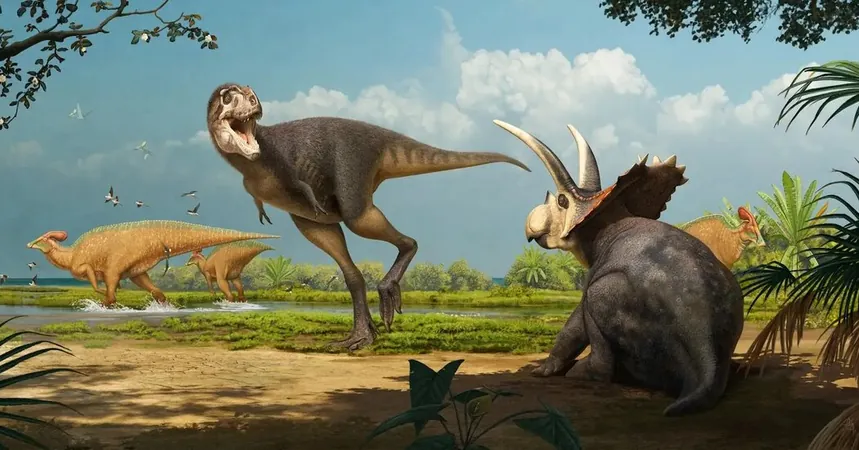
Discovering a New Species: A Long-Legged Relative of T. rex Found in Mexico’s Desert
2024-09-25
Introduction
For two decades, a collection of dinosaur bones remained tucked away in a drawer at the Museo del Desierto in Saltillo, Mexico, seemingly unremarkable to the untrained eye. But paleontologist Nick Longrich from the University of Bath in England recognized the potential of these bones, which had been discovered in the Chihuahuan desert in 2000. What initially looked like a pile of rubble has now been revealed to be a significant find in paleontology.
Discovery of *Labocania aguillonae*
This collection belongs to a newly identified species closely related to the famed Tyrannosaurus rex, named *Labocania aguillonae* after local paleontologist Martha Carolina Aguillón, who was instrumental in its discovery. Unlike the stocky and powerful T. rex, this species boasted long legs and a lighter frame, suggesting it was more agile, potentially employing its large eyes for hunting in low light and a robust snout for catching easy prey.
Significance in Paleontology
*Labocania aguillonae* is now recognized as just the second tyrannosaur species ever identified in Mexico, further highlighting the diversity of these ancient predators in what is now North America. The research, published in the journal MDPI Fossil Studies, emphasizes the emergence of a unique cluster of southern tyrannosaurs that were distinct from their northern counterparts, such as *Albertosaurus* and *Daspletosaurus*.
Fossil Record and Lineage
Seventy to eighty million years ago, the western regions of North America were teeming with various tyrannosaur species. While most were uncovered in the vast plains of Canada and the U.S., a few notable species have since been identified in states like Utah and New Mexico. The fossil record detailing Mexican tyrannosaurs, however, has remained quite sparse. The earlier species, *Labocania anomala,* is known only from jaw bones discovered in Baja California, making this new find particularly valuable, as it includes skull fragments, vertebrae, and limb bones.
Evolutionary Insights
Longrich and his colleagues assert that *Labocania* belongs to a lineage known as *Teratophonii*, which is more closely related to *T. rex* compared to northern species. This discovery suggests a previously underestimated variety of tyrannosaurs inhabiting late Cretaceous North America.
Geographical Distribution and Diversity
Interestingly, although these towering predators could dominate their environments, they seem not to have inhabited large areas, leading to a distinct pattern of geographical distribution. In contrast, mammals today—such as lions and wolves—populate wide-ranging habitats. Longrich emphasizes the growing understanding that these ancient reptiles do not fit this classic predator pattern.
Skepticism and Methodological Concerns
However, some experts, like Thomas Holtz from the University of Maryland, caution against jumping to conclusions based on the fragmentary nature of the *Labocania* fossils. Meanwhile, Thomas Carr of Carthage College expressed concerns regarding methodological issues that might affect the team’s findings.
Ecological Factors and Distinct Species
Amid ongoing debates about the geographic diversity of dinosaur species in Cretaceous North America, Dr. Héctor Rivera-Sylva argues that herbivorous dinosaurs from Mexican excavations show marked differences from those found further north, supporting the premise of distinct species shaped by ecological factors.
Future Discoveries in Mexico
As paleontologists shift their focus toward Mexico's rich Cretaceous deposits, the potential for uncovering new specimens is vast. Rivera notes the importance of continued study in what he terms a significant gap in understanding Late Cretaceous tyrannosaur diversity.
Conclusion
Longrich optimistically asserts, “There’s a lot more in there than we realize, and a lot more waiting to be found.” The discovery of *Labocania aguillonae* marks an exciting chapter in our understanding of dinosaur diversity, evolution, and the ecological complexities of prehistoric North America. Who knows what other secrets lie hidden in the depths of Mexico’s deserts?


 Brasil (PT)
Brasil (PT)
 Canada (EN)
Canada (EN)
 Chile (ES)
Chile (ES)
 España (ES)
España (ES)
 France (FR)
France (FR)
 Hong Kong (EN)
Hong Kong (EN)
 Italia (IT)
Italia (IT)
 日本 (JA)
日本 (JA)
 Magyarország (HU)
Magyarország (HU)
 Norge (NO)
Norge (NO)
 Polska (PL)
Polska (PL)
 Schweiz (DE)
Schweiz (DE)
 Singapore (EN)
Singapore (EN)
 Sverige (SV)
Sverige (SV)
 Suomi (FI)
Suomi (FI)
 Türkiye (TR)
Türkiye (TR)